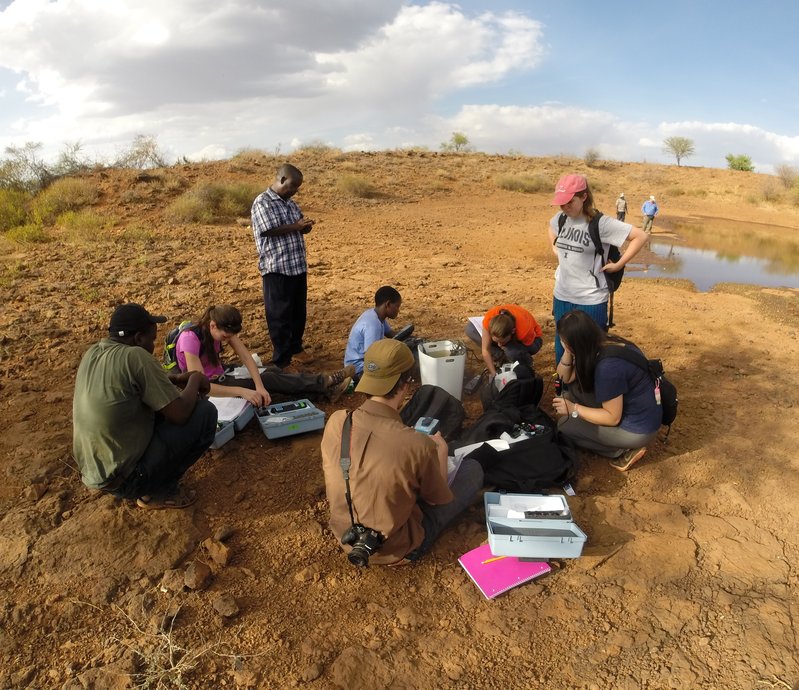WATER TREATMENT DESIGN FOR LAKE BARINGO AND NAKURU, KENYA
Baringo and Nakuru, Kenya
Improving Drinking Water Quality and Availability at Awuor Pan, Kenya
Bondo, Kenya
The Awuor Pan is located in the Bondo district in the Atili sub-location. The pan is the primary water source in the area; the perimeter measures 46 ×27 m, and the pan depth changes depending on the season. When the pan gets full during the rainy season the water generally lasts 1.5 months in the subsequent dry seasons. This intermittent availability of water is a major concern in the community that would prefer to count on a more reliable clean drinking water source. Livestock has free access to the pan and this situation represents a high risk of water contamination by animal waste and enteric waterborne pathogens that are transmitted via fecal-oral route. This situation affects the health of people relying on this water source for drinking purposes.
The recommended approach is a combination of source protection systems and household level solutions. An initial design component for water management is to install fences to keep animals away from the pan, and adjacent troughs for animals to drink from. This effort is expected to reduce the amount of contamination from animal feces at the source. Once water has been collected and transported to the households, sedimentation, filtration, and disinfection steps for treatment are required. Local construction and implementation of biosand filters is proposed as one of the possible solutions to improve water quality. Additionally, the usage of a locally available disinfectant will provide the targeted level of pathogen control. Individual rainwater harvesting systems and reliable safe storage with enough capacity for rainwater throughout the year are another important component of the proposed design solutions. These rain water systems would provide an alternative source of water of better quality. Educational programs to assure adequate implementation and maintenance of the biosand filters and/or the rainwater harvesting systems in collaboration with local partnering institutions and organizations are a priority in this effort.
Improving Drinking Water Quality and Availability at Majengo Pan, Kenya
Bondo, Kenya
The Majengo Pan serves approximately 4,000 people from 5 surrounding villages. Only half of the construction is completed resulting in water loss during rain events. This water source is about 47 m in diameter. Community members of the surrounding area had dug a small ditch near the pond in an effort to capture excess water flow in rain events. The water coming from the Majengo Pan has been reported to cause gastrointestinal illnesses among the population that use it as their drinking water source. Monthly water education seminars have been organized in the area, however many people still do not treat the water before drinking it.
The main priority of community members is a larger pond and better access to clean drinking water. A rainwater harvesting system is already in place and a system conformed of several water kiosks is available in the area. However, this infrastructure is not properly maintained and not fully functional. The construction of the Majengo Pan needs to be completed to increase its water retention capacity. Along with this, the installation of a water storage tank to complement and improve the rainwater harvesting system is required. The kiosk system that is currently in place can also be improved by adding a storage tank and a rain water catchment system to the nearest kiosk. Improved cook stoves are also considered as part of the approach since the most common treatment method in the area is boiling paired with overnight sedimentation to decrease the turbidity of the water. Most people in the community do not seem to be open to other point-of-use treatment options.
Improving Drinking Water Quality and Availability at St. Lazarus Primary School, Kenya
Bondo, Kenya
Many regions in Bondo province (pop. 158,000) lack access to safe, reliable water sources. Barriers to safe water include prohibitively expensive drinking water kiosks, contaminated manmade shallow ponds that are shared with livestock and shallow wells that can be contaminated during the rainy season. Many water sources are unable to meet the needs of the community and can run dry. As a result, locally available poor quality water is used or water is transported between communities, sometimes over great distances. As an example, each day nearly 1,000 school children (ages five to fourteen) must carry water from home to St. Lazarus Primary School because it lacks a water source.
Collaborating with Bondo District Water, the Safe Global Water Institute team is working on sustainable technologies to provide access to safe water for the people of Bondo. In the case of St. Lazarus a rainwater catchment system was designed as a possible solution. The proposed system consists of six storage tanks for a total capacity of 100,000 liters of water. The construction of this system will allow rainwater to be captured and stored so there will be water available for every student throughout the year. This approach would allow the SGWI use this system as a proof-of-concept for further implementation throughout Bondo.





